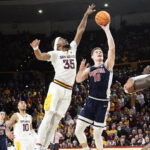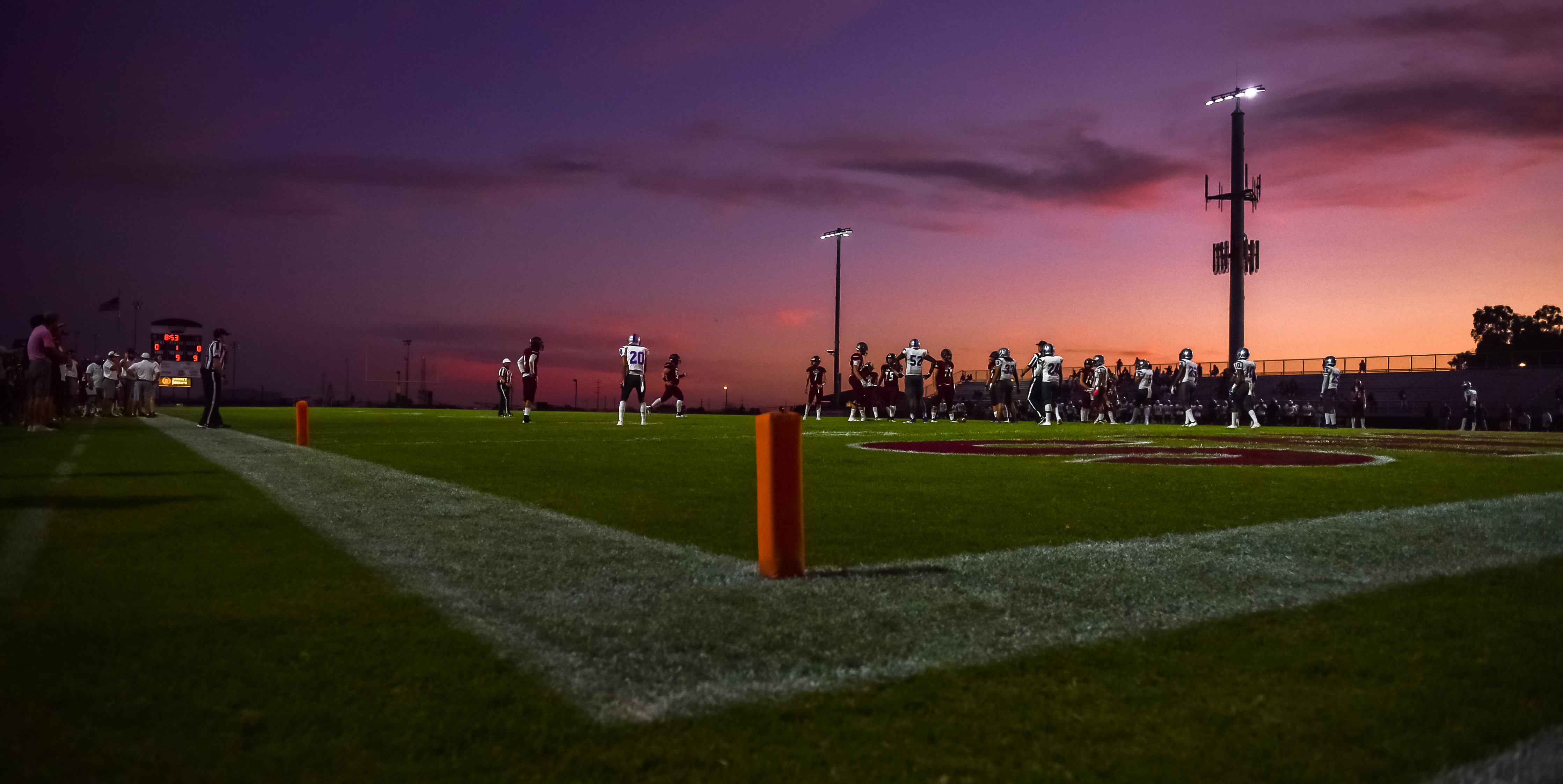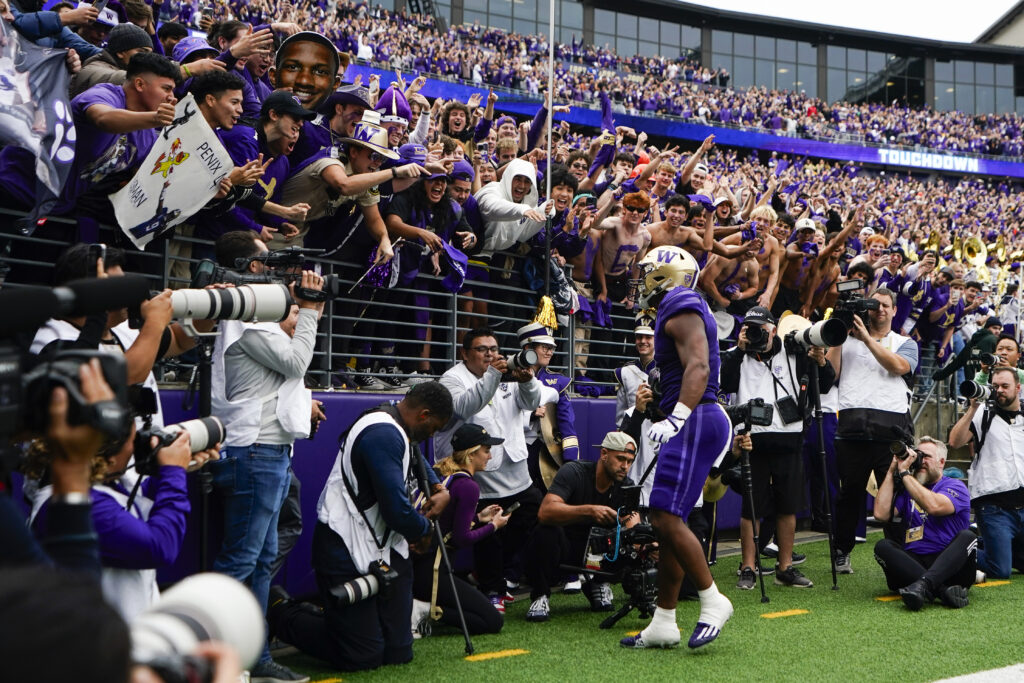Instant reaction to Pac-12 developments on the field …
1. For the ages
It says something that the fourth-largest comeback in conference history — Stanford’s 29-point, triple-overtime rally to slay Colorado — wasn’t the most compelling game of the weekend.
And this is what it says: Oregon-Washington was an all-timer.
The first meeting of the bitter rivals when both were ranked in the top 10 carried Pac-12 championship, College Football Playoff and Heisman Trophy stakes — plus a visit by ESPN’s ‘College GameDay’ and dozens of NFL scouts. And it more than met the occasion.
“That was an amazing football game,” Huskies coach Kalen DeBoer said after UW’s 36-33 victory.
The two heavyweights were at the top of their games. They traded big plays and the lead, combined for 956 yards, converted 15-of-27 third-down attempts, committed just 10 penalties and had a single turnover.
It was spectacular, especially for the Huskies, who are one of only eight undefeated teams in the Power Five, and for quarterback Michael Penix Jr., who delivered a Heisman moment with his two-play touchdown drive in the final minutes.
2. Wash, rinse, repeat
On the other hand, it was spectacularly bad for Oregon coach Dan Lanning, whose flawed decisions doomed the Ducks for a second consecutive year against their sworn enemy.
Lanning twice passed on short-range field goals in favor of fourth-down attempts, costing the Ducks six points and invaluable momentum. But his most confounding decision came with two minutes remaining and a 33-29 lead.
Facing fourth-and-three at Washington’s 47, Lanning kept his offense on the field.
A punt would have pinned the Huskies deep and forced Penix, who was in obvious physical distress at that point, to take UW the length of the field against an Oregon defense that found its backbone in the second half.
Instead of playing it safe, Lanning played it recklessly. Quarterback Bo Nix’s fourth-down pass was incomplete, the Huskies took charge near midfield, and Penix, supercharged after the change of possession, ripped off a two-play touchdown drive to give UW a 36-33 lead.
Lanning’s decision mirrored the gaffe he made 11 months ago in Eugene, when he ordered Nix to stay on the field for fourth-and-1 at Oregon’s 34 with just over one minute remaining in a tie game.
UW stuffed the conversion attempt and kicked the winning field goal.
This time around, the Huskies took possession near midfield and scored the go-ahead touchdown with 1:38 remaining. They secured the victory when Oregon missed a 43-yard field goal as time expired.
The score this time: UW 36, Ducks 33.
The score last time: UW 37, Ducks 34.
Did Lanning not learn his lesson? Can he not distinguish between an aggressive approach and reckless decisions?
Combine the short field goals that he didn’t try Saturday afternoon with the short field he gave the Huskies and you have a 13-point swing in a three-point game.
His comments after Saturday’s loss: “This game’s 100 percent on me.”
His comments after last year’s loss: “This game 100 percent falls on me.”
He’s being paid handsomely to not repeat his mistakes, especially against the hated Huskies.
3. The CFP calculation
Lanning’s wayward decisions aside, the outcome impacts Oregon more than Washington.
As the College Football Playoff is concerned, UW’s calculation hasn’t changed. The Huskies (6-0) were a leading contender with margin-for-error prior to kickoff, and they were a leading contender with margin-for-error at the final whistle.
But the dynamics have changed for Oregon. The Ducks (5-1) were a leading contender with margin-for-error prior to kickoff, but they are now a second-tier contender with zero margin-for-error.
Two losses, and you’re out of the running.
The Huskies have no losses; the Ducks have one.
The Huskies can afford one defeat in league play; the Ducks cannot.
4. An ideal scenario
If the Pac-12’s goal is to maximize options for sending a team to the playoff, then the right team won Saturday in Seattle.
If the goal is to finish the regular season with at least two teams in the CFP chase, then Washington’s victory was the best possible outcome.
Why? Because the Huskies have a more difficult closing schedule than the Ducks.
Each team has six games remaining, and five are against common opponents: Arizona State, Oregon State, Washington State, Utah and USC.
The uncommon games: Washington visits Stanford; and Oregon hosts Cal.
But within the points of commonality, there is a difference. The Ducks have one tough road game (at Utah), while the Huskies have two (at USC and Oregon State).
We view a first loss by UW as more likely than a second loss by Oregon. And if neither finishes with two losses, they will meet again in the conference championship game in Las Vegas as 11-1 combatants, with the winner assured of a playoff berth.
Had the Huskies lost today, with that rugged road schedule awaiting, then the endgame would look like two-loss UW against no-loss Oregon. Under that scenario, a playoff berth would be anything but guaranteed.
5. The path narrows
To this point, we have only mentioned Washington and Oregon as playoff contenders because, well, that’s the extent of the Pac-12’s uppermost tier.
USC suffered its first loss of the season this evening, a 48-20 wipeout at Notre Dame in which every weakness was exposed. (The Trojans’ offensive line was such a mess that we briefly forgot how bad the defense is.)
As a result, USC must run the table to reach the CFP and have upcoming dates with Utah, Cal, Washington, Oregon and UCLA.
Unless Lincoln Riley finds a new offensive line and an entirely different defense, the Trojans have no chance to win all five and the conference championship. A second loss is inevitable. And a third might be, as well.
As the CFP is concerned, they are done.
The Pac-12 has two other one-loss teams, Utah and Oregon State, but the Hotline is wary of declaring either a legitimate CFP contender.
The Beavers have looked sharp at home but a tad wobbly on the road, and they have upcoming trips to Boulder and Tucson, plus the season finale in Eugene.
Meanwhile, the Utes are without quarterback Cam Rising. The longer he goes before returning to the field, the less chance of him reaching top form before the season concludes.
Without Rising at his best, the Utes cannot navigate a stretch run that includes USC, Oregon and Washington.
Until proven otherwise, we view the Pac-12 as possessing two playoff contenders and three playoff pretenders.
Compared to previous seasons, that’s a stockpile of riches.
*** Send suggestions, comments and tips (confidentiality guaranteed) to pac12hotline@bayareanewsgroup.
com or call 408-920-5716*** Follow me on Twitter: @WilnerHotline
*** Pac-12 Hotline is not endorsed or sponsored by the Pac-12 Conference, and the views expressed herein do not necessarily reflect the views of the Conference.
Related posts:
 Hotline mailbag: The reward (and risk) of waiting to sign a media deal, Kevin Warren, Brock Purdy, Oregon, UW and more
Hotline mailbag: The reward (and risk) of waiting to sign a media deal, Kevin Warren, Brock Purdy, Oregon, UW and more

(AP Photo/Darryl Webb)
Pac-12 basketball: A breakdown of the seeds, matchups and nitty-gritty as the conference tournament looms
(AP Photo/Darron Cummings)
Pac-12 basketball: NBA Draft decisions, transfer portal moves wallop the conference (but there’s time to mitigate the impact) Wilner Hotline – Pac-12 recruiting: How the top 2023 prospects would rank in a future NFL Draft
Wilner Hotline – Pac-12 recruiting: How the top 2023 prospects would rank in a future NFL Draft
Jon Wilner
Jon Wilner has been covering college sports for decades and is an AP top-25 football and basketball voter as well as a Heisman Trophy voter. He was named Beat Writer of the Year in 2013 by the Football Writers Association of America for his coverage of the Pac-12, won first place for feature writing in 2016 in the Associated Press Sports Editors writing contest and is a five-time APSE honoree.
